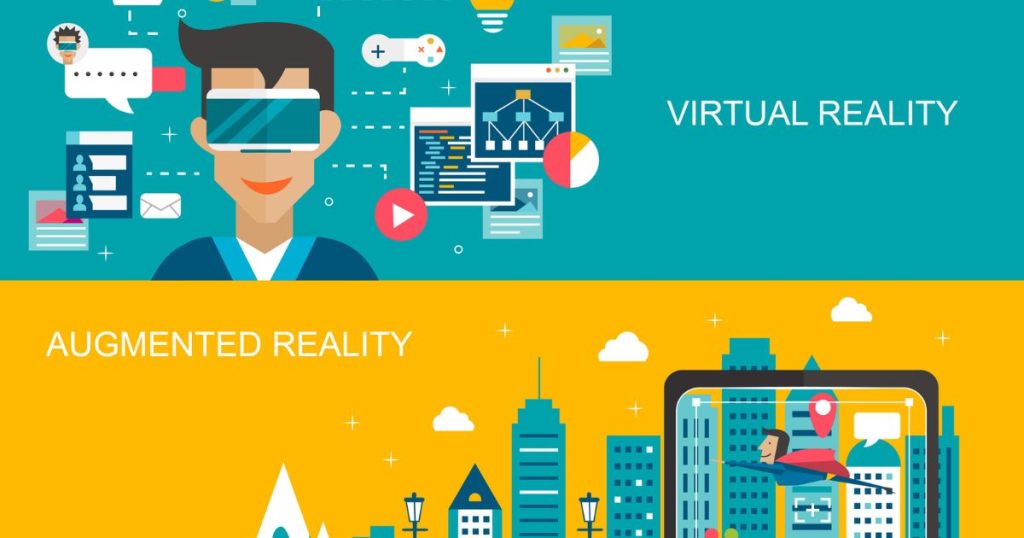Have you known the differences between augmented reality vs. virtual reality? These cutting-edge technologies are considered the most significant factors in this digital world. However, many people are still unable to distinguish these terms correctly. Augmented Reality (AR) uses a smartphone’s camera to overlay digital elements on a live scene. Virtual Reality (VR), on the other hand, means a full immersion experience that excludes the physical world. Keep reading to explore more about the differences between augmented reality vs. virtual reality.

What Is AR?
Augmented Reality or AR is the real-time integration of digital information with the user’s environment. Unlike virtual Reality (VR), which generates an entirely created environment, augmented reality (AR) lets users encounter a real-world environment with produced information superimposed.

The primary advantage of AR is that it combines digital and three-dimensional (3D) components with a person’s view of the actual environment. AR offers a wide range of applications, from medication to entertainment.
Nowadays, there are many augmented reality services available on the market to meet the various demands of customers. You can choose many types of AR technology offered by some 3D modeling companies such as market-based, market-less, and location-based augmented reality.
Related article: history augmented reality
What is VR?
Virtual Reality or VR refers to the use of computer technology to make a simulated environment that can be explored in 360 degrees. Unlike traditional interfaces, virtual reality immerses the user in the virtual environment.

The goal of virtual reality is to create a new reality. The user may observe and engage in the digital environment by utilizing a VR screen, which requires the employment of two lenses between the user and the screen. They analyze eye movement and adjust individual movement to the VR. As a result, powerful hardware is needed in this situation to insulate the user from the actual environment.
8 Differences Between AR and VR
The main difference is that VR aims to replace the actual world with complete immersion. In contrast, AR strives to overlay the virtual by projecting digital information on the user’s current environment. Let’s scroll down to see more differences mentioned in the table below:
| Augmented Reality | Virtual Reality | |
| Purpose | The system augments the real-world environment by adding to it. | Technology entirely substitutes reality and stimulates the virtual environment. |
| Sense | AR users constantly experience a sensation of being present in the actual world. | The system controls the visual senses in VR. |
| Immersion | This technique immerses the user in the activity to some extent.With AR, people maintain contact with the actual world while interacting with virtual items closer to them. | This technology immerses the user in action.VR technology isolates the user from the actual world and immerses him in a wholly imaginary environment. |
| Virtual vs. real experience | 25% virtual and 75% real | 75% virtual and 25% real |
| Purpose of enhancement | AR enhances both real and virtual worlds | VR improves fictional reality serving the gaming world |
| Bandwidth | AR needs up to 100 Mbps of bandwidth for high-quality experiences | VR needs a minimum connection speed of 50 Mbps. |
| Headset | AR headset is not required | Some AR headset is required |
Pros and Cons of Using AR?
Although AR is one of the most state-to-the-art technologies nowadays, it still has some pros and cons, which can be good or harmful to our life. Let’s consider the advantages and disadvantages of using AR now:
Advantages Of Using AR

- Enhancement Of Experience: The fundamental goal of augmented reality is to integrate the virtual and real worlds, enhancing the user’s experience with the natural environment by crossing it with simulated gen.
- Ease Of Use: The development of AR software for Android and iOS devices is the clearest sign of the most recent online and physical purchasing experiences. Digital dressing rooms can help customers acquire the right size, reducing the frequency of returns.
- Interaction Of Society: AR aims to develop technology that socially connects people. Pokemon Go is a typical example of AR technology in action. The game has dramatically improved society by communicating with players socially.
- Educational Tool: One of the benefits of augmented reality is its potential as an educational tool with rich material. The information is based on precise GPS coordinates and gives navigation and instructions without needing paper maps.
- Improved Technology: Scientists frequently use augmented reality for training and surgical guidance in the medical industry. AR has also assisted in learning some diseases, such as dyslexia and ADHD, by making them more exciting and engaging than traditional methods.
Disadvantages Of Using AR

- High Price: AR includes some features that can benefit both individuals and organizations. Businesses may improve their systems and services with the help of augmented reality. That is the reason why AR technology costs too much.
- Assaults Confidentiality: One of the primary disadvantages of augmented reality is the obligation to create, analyze, and gather large amounts of data. The issue of confidentiality is considered while dealing with such data.
- Problematic Situation: Games like Pokémon Go may demonstrate the drawbacks of augmented reality. Because it adds digital gen to the actual environment, augmented reality can obscure real-world signals from the user’s sight.
- Addiction: Augmented reality technology can be addictive since players may become engrossed in the game for several hours. Addiction is associated with several health problems, including vision problems, obesity, difficulty concentrating, and chronic disease.
- Psychological Harm: Many violent games, whether connected to war or crime, have harsh impacts that might influence one’s perspective. These sorts of games psychologically affect the players, especially the younger generation, encouraging them to assume that aggressive behavior in society is acceptable.
Pros and Cons Of Using VR?
Similar to AR, VR has some advantages and disadvantages you need to consider before using it.
Advantages Of Using VR

- Various Industries: Virtual Reality has been available in multiple sectors, including the military, education, and health care, due to its all-around features. Moreover, virtual reality is also utilized in aviation and architecture to observe the finished project.
- Excellent Experience: Virtual reality allows people to investigate the actual world. Films for VR enable them to see the entire environment in every scene. As a result, it provides them with an interactive watching experience.
- Detailed Views: Virtual Reality provides a complete and comprehensive perspective of a location. For example, virtual reality makes visiting tourist attractions more entertaining and convenient. It provides a detailed glimpse of a location that you wish to visit. Therefore, viewers may plan their vacation by seeing the actual locations of that place.
Disadvantages Of Using VR:

- Expensive: One of the primary disadvantages of virtual games is that they are only affordable to some. It is costly, and those who cannot afford it can’t adopt this technology.
- Loss of Human Connections: Virtual Reality may cause faulty connections not present in real-life social environments, which might lead to sadness and disassociation depending on the intensity.
- Health Effects: The use of virtual reality for an extended period might result in loss of spatial awareness, dizziness, confusion, and nausea.
4 Applications Of AR
Medication
AR has been effective in providing a variety of algorithms that can manage complicated medical conditions in patients and categorize data from various types of surgery.

Medical imaging is an example of AR in the medical industry. Surgeons, neurologists, or chemotherapists may conduct various forms of diagnosis to provide medicinal advantages to their patients by entirely evaluating their physical parts.
Entertainment
AR has significant marketing potential because entertainment firms can blend their branded content with the characters their audiences like most.

Many entertainment applications use the Augmented Reality Technology concept, but the most well-known is Snapchat and Google Lens. Each application may enhance the experience with eye-catching filters, stickers, lenses, and user-friendly emoticons.
Tourism
Various agencies and hotels are employing AR-based travel applications to assist their clients in exploring their locations without sacrificing the quality of transportation and dining venues with interactive dish menus that correctly map tourists’ eating preferences.

World Around Me, Smartify, ViewRanger, and AR City are a few travel agencies and hotels that use Augmented Reality to improve the experience of tourists.
Education
Augmented reality can collaborate with teachers and other educators, such as college professors, to ensure that students of all ages fully understand the contents covered in their curriculum.

For example, Google Earth (an AR-based program) allows students to search for zooming, rotating, or tilting three-dimensional images of our world.
You may also be interested in: how does augmented reality work?
4 Applications Of VR
Automation
Engineers and designers may easily experiment with the appearance and build of a car using virtual reality before buying expensive prototypes.

Companies like BMW and Jaguar Land Rover (JLR) have been utilizing virtual Reality (VR) for years to conduct early design and engineering evaluations to ensure the vehicle’s visual design and object obscuration.
Real Estate
You may advertise any property long before it is created by using 3D visualization and virtual apartment or home tours. For that reason, the absence of actual goods will never hamper the job of real estate brokers, which is excellent news.
Architecture
VR allows you to visualize how a structure or area looks and feels.
For example, if someone wants to build an extension to their home, they can see what the area would look like before it completes and then make real-time adjustments.
Interior Design
VR is transforming more than just the construction of your house. People may now use immersive experiences to replicate the home design.

Platforms like VR not only assist designers and homeowners in visualizing the look and feel of a house, but they also can generate direct sales for furniture businesses.
FAQs
Are AR and VR the same?
No, they aren’t. In simple words, AR augments a real-world scene while VR produces an immersive virtual experience.
What Are 3 Types Of Augmented Reality Or Virtual Reality?
Three augmented reality types combine digital and physical worlds, interactions done in real-time, and precise 3D identification of virtual and actual items. Meanwhile, virtual reality simulations today are classified into three types: non-immersive, semi-immersive, and fully immersive.
What Is The Difference Between AR, VR and AI?
While AR and VR are about connecting with the actual world in some manner, AI is about systems learning to solve problems on their own. It’s about computers learning – analyzing massive quantities of data, discovering connections, and learning to make decisions.
Conclusion
As you can see, although augmented reality vs. virtual reality both play a vital role in our daily lives, they still have different features. Hopefully, this article will give you the most useful information. If you still have any questions, do not hesitate to contact us for more information!

Related Posts: